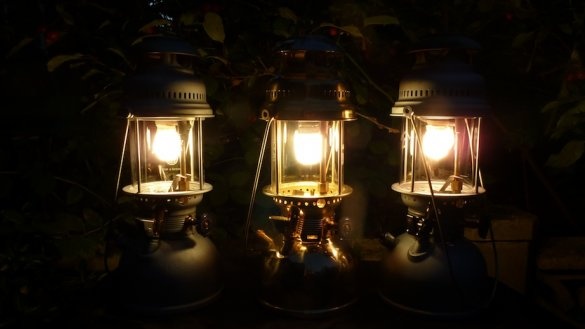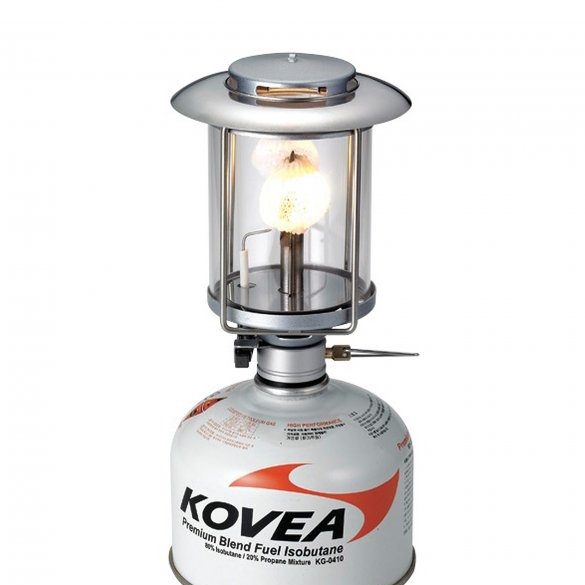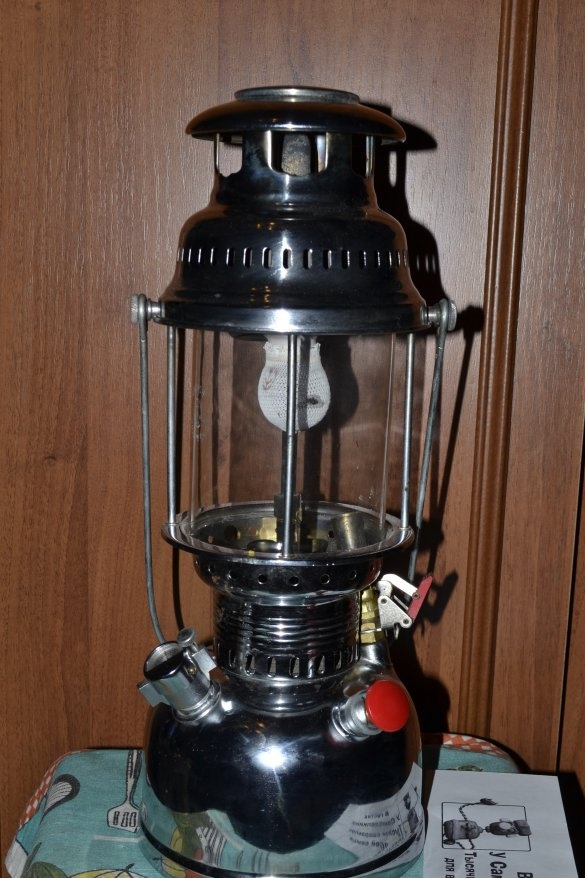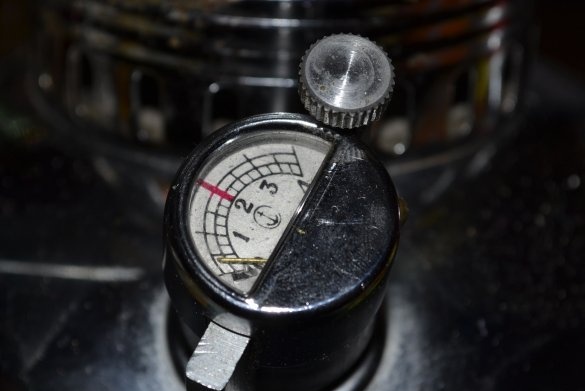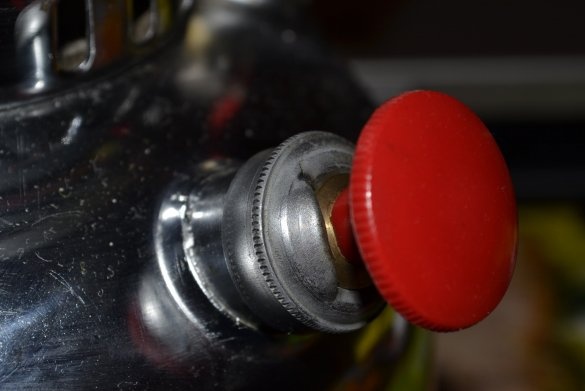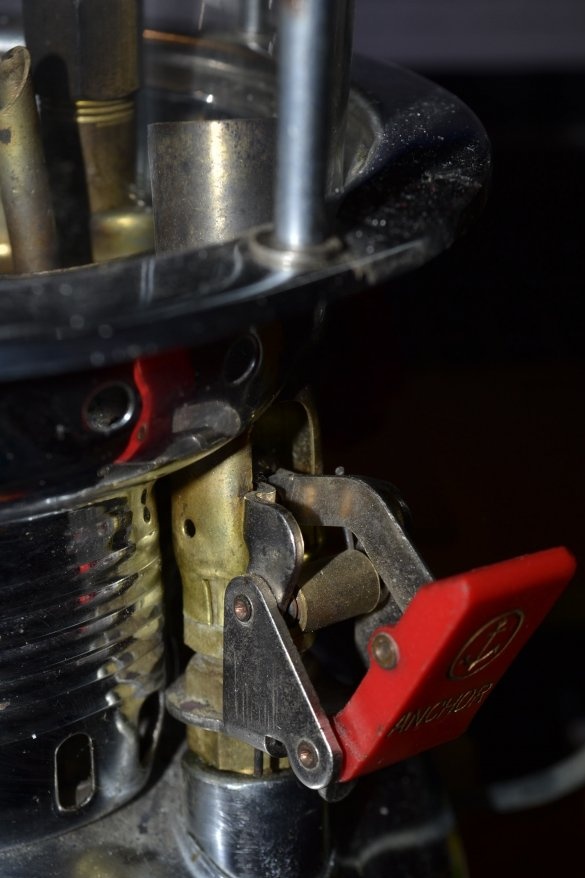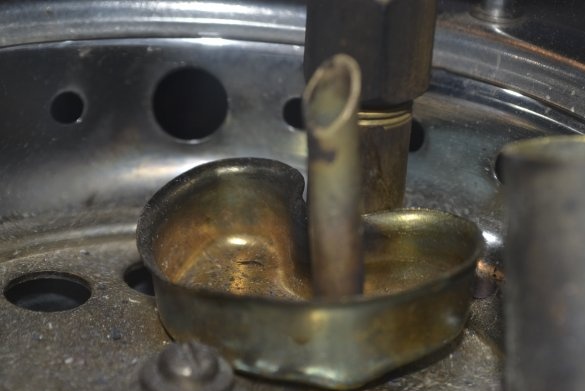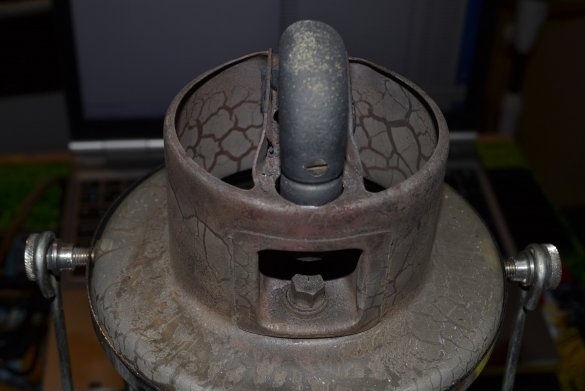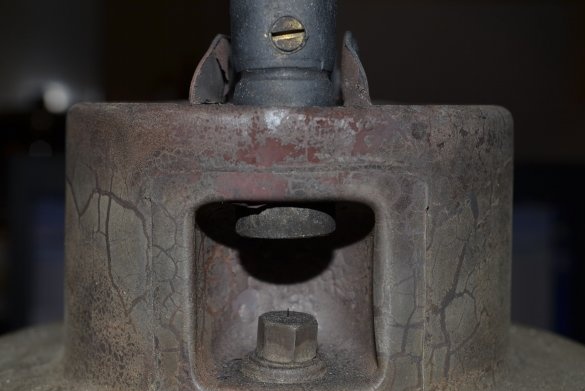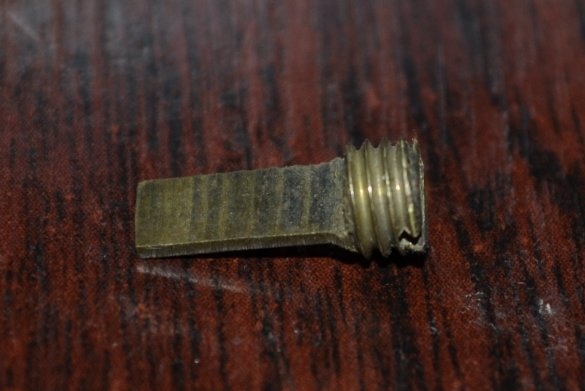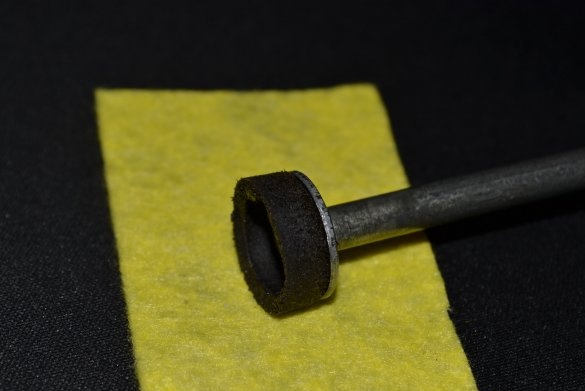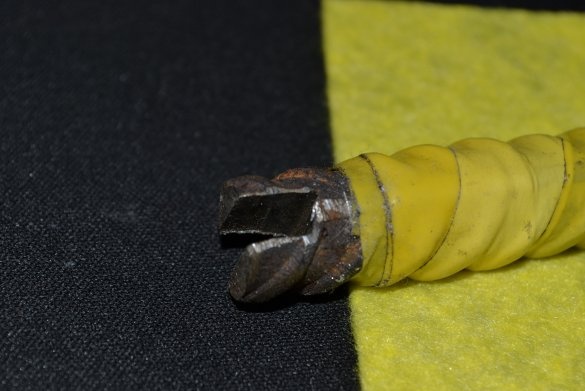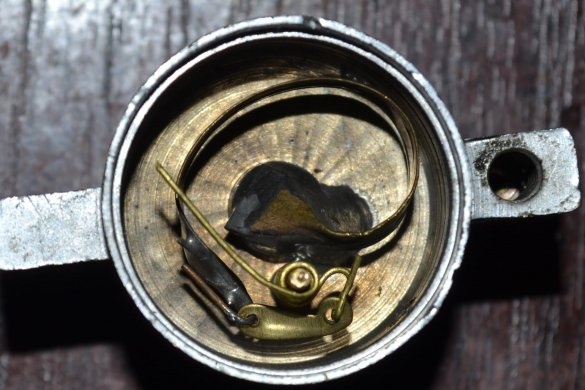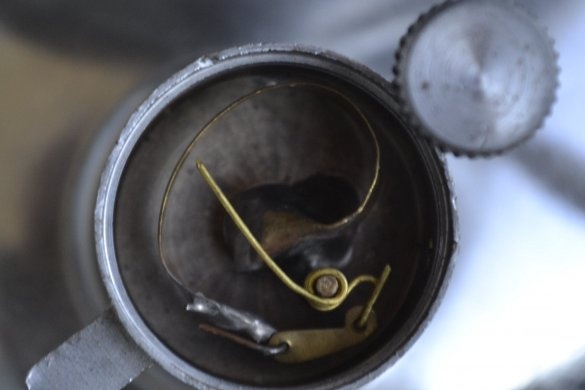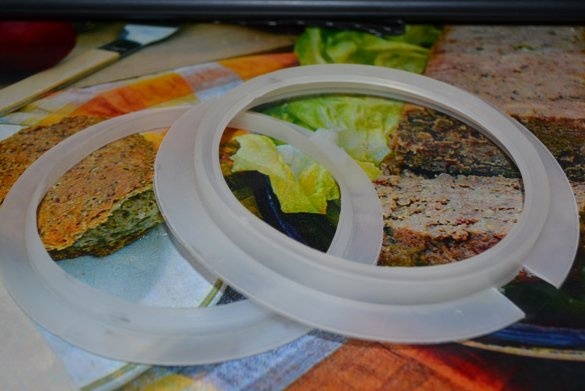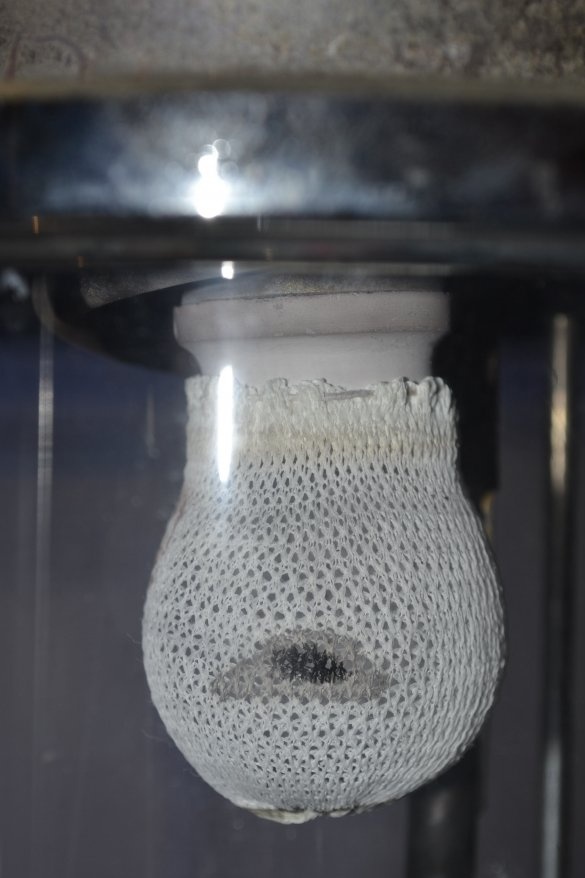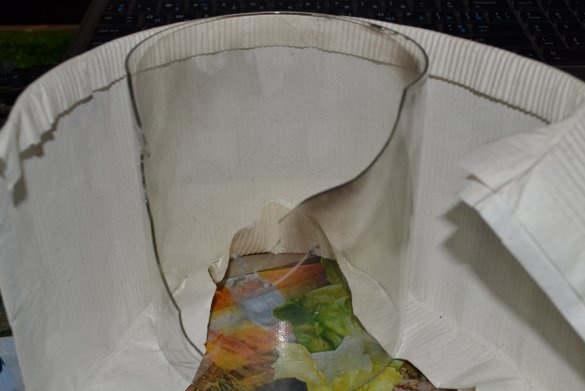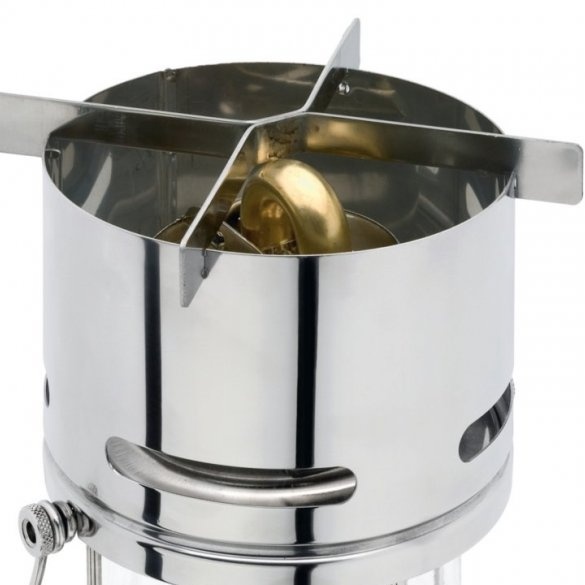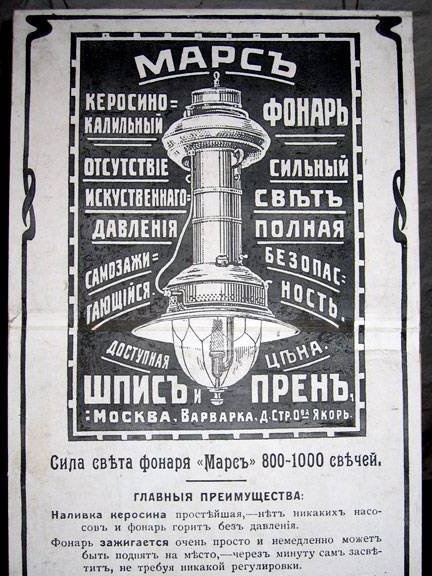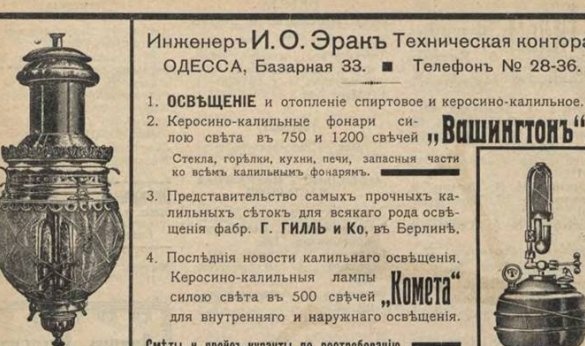Greetings. For over a year now I have been the owner of one interesting thing - a high-pressure kerosene lamp. I once posted an article on how sewed a cover for her, in which he hinted that I would share my experience in its use and my opinion about the lamp in general. I think the time has come.
It so happened that the Soviet industry decided to bypass this type of device, so many will be the first to ask: what is it all about? Perhaps I'll start with the fact that with the usual kerosene lamp, with the exception of the type of fuel, this device has nothing to do. Its design is more akin to a primus stove, like the kerosene Record-1. Kerosene from the tank under pressure enters a special chamber - a steam generator. This chamber warms up well before starting (in the process the temperature is maintained by the work itself), in a preheated chamber kerosene instantly goes into a gaseous state, is sprayed through a nozzle into a carburetor, where it is mixed with oxygen from the air and burned through a special ceramic burner. Around the burner a special net is tied up - a heating net. Karl Auer von Welsbach invented this grid at the end of the 19th century; in fact, for a long time it was called Auer caps. This grid is impregnated with rare earth oxides, and uses a phenomenon such as candoluminescence - the conversion of the infrared spectrum (read heat) into the visible one. In simple terms, when heated in a burner flame, these oxides are heated to a very high temperature, emitting bright, white light. If someone is interested in the history of kerosene appliances - you can read an article on this topic on my blog.
Now, in fact, these nets have become popular in gas camping lanterns, working on the same principle (but from compressed gas in a cylinder).
We figured out the principle of work, let's move on to an overview of the controls and interaction with the device. The device itself, in fact, looks like this:
On the tank there is a neck with a lid, in which a pressure gauge and a pressure relief screw are mounted. By the way, much depends on the efficiency of the pressure gauge.
On the other hand a pump.
Nearby is the Rapid valve of the burner for heating the steam generator, for a quick start. More details below.
The handle for cleaning and adjusting the supply of kerosene. To the left - clean the nozzle, to the right - open.
Inside you can see a special container.This is a container for alcohol, which heats the steam generator. For a soft start.
For refueling in the casing on the side there is a special hole. It can be seen from behind, behind the tank.
Under the hood is a carburetor.
You can configure it in two ways - raising and lowering the tube itself (for this model the optimum clearance is 16 mm) and turning this bolt, which is actually not a bolt, but a damper.
I think some improper mixture is unlikely to get them screwed, but the unconfigured carburetor is the cause of excessive lamp noise during operation.
Doping
This lamp is called Ancor№950 (however, it also comes under other names, for example Butterfly, AIDA), and is a complete, by the way, fairly high-quality, clone of the Petromax lamp. High-quality enough to say it, but not enough to work from the box) I bought my lamp almost new, in a box and a complete set, according to the previous owner, it started once, after which it stood for several years the garage. Having received the long-awaited package, of course, I immediately ran home to launch it. But it was not there. And so, what you may have to face if you decide to purchase such a lamp:
1. Inoperative pump. Over the years, the cuffs dry out. If you are lucky - to be treated simply by lubricating the cuff with solid oil, if not - get ready to make a new cuff yourself, to find ready ones is unrealistic.
2. A stuck pump check valve. The reason is the same - long-term storage without maintenance. Unscrew the valve is not so simple, for this you need a special key. It’s not difficult to do it yourself.
The valve is disassembled, flushed, lubricated and screwed back.
3. Inoperative pressure gauge. You can basically buy a new one on ebay, from the original lamp. You can try to fix it. To do this, unscrew the screw holding the cap, remove it and the dial, screw it back in, pump up pressure and see how it behaves. In my case, I just had to bend the arrow. If the cochlea does not react to pressure in any way, it is possible that when soldering, the solder enters the channel through which compressed gas flows to the cochlea. Gently, with a thin drill, rotating your fingers so as not to pierce the snail, drill it from the back. If it does not help - trouble. Need a new one.
4. We adjust the carburetor. According to Gideon (every primusologist in the Russian-speaking segment knows who he is), the optimal clearance for most of these lamps is 16 mm. I did not experiment, set as he said and yes, the noise of the lamp fell significantly. With an unconfigured carburetor, the lamp made a very high noise level, at the level of human speech, which completely makes it useless when evening gatherings with a guitar. After tuning, the noise fell to a slight hiss, roughly like a gas oven. Additionally, fine tuning is carried out by a damper, but it does not affect much.
It is not necessary that you have to face all these jambs. But it’s not a fact that you don’t have to face something more serious. So one forum member had to sort out the entire fuel system ...
To take or not?
Now, given the above, without delay we turn to the question of whether to buy.
Behind. The lamp is really made of thick tin, picking up a completely absent feeling that you are holding a tin can, as is often the case with Chinese crafts. Most likely the Chinese somewhere stole blueprints and do it strictly according to them, or maybe they even stole the machines. However, what kind of goods you receive is fortunetelling on coffee grounds. From fully operational to completely inoperative. If you are ready to work with your hands and it does not cause discomfort for you - take it. An important “for” is of course the price. Even a new lamp is several times cheaper than the original, but I took it from my hands for 20 bucks.
Against . If a proponent of the idea bought a product - it should work like a clock, with which I basically agree - do not take it. Buy the original Petromax, Coleman or Primus, but also count on the appropriate budget.
Foreshadowing the question, who should buy this?  There is something ... lamp
There is something ... lamp  Warm and pleasant, unlike cold, soulless LEDs.
Warm and pleasant, unlike cold, soulless LEDs.
So, sort of sorted out all the questions. Pump pumps, manometer manometer.
Proper lamp operation
The question is extremely important. One genius dashed off an entire article in Runet on the subject of which Chinese are glupie glupie, did you see the plastic o-rings that flowed during his first start and lit up the entire lamp. Open the instructions and read the genius of the mind was not enough. And it says something like the following: "Before the first use, be sure to remove the plastic shipping rings!". That is, it is already understandable that they are needed so that the glass does not teleport during transportation, but apparently not for everyone. Okay, generally remove the rings.
Preparation for launch
To install the grid, remove the top cap, remove the carburetor, glass. Tie a mesh to the burner, for this there is a special tie on it, and on the burner there is a ledge. Put the carburetor back in place (do not put the glass yet), straighten the net, pour a little alcohol and set it on fire. The grid during firing is significantly reduced, alcohol is needed for more uniform firing and the adoption of the desired shape by the grid, but you can burn without it. After firing, the reinforcing fibers necessary for transportation and convenient installation burn out from the mesh, so after this we carry out all the procedures very carefully.
Carefully get the carburetor with the mesh, put the glass in place, put the carburetor with the mesh in place. We put the cap, tighten the bolts. We fill the lamp with kerosene. Lighting kerosene is still easy to buy in any household goods. It doesn’t cost to pour “as much as you like”, the tank should be 2/3 full to provide the necessary space to create pressure with the pump.
Launch
In almost all of these lamps, the manufacturer has laid the possibility of two types of starting: a soft start and a rapid burner. All collectors and active users strongly recommend using only a soft start, and not casual. When starting a rapid burner there is a non-illusory risk that the glass will burst. It also does not particularly well affect the ceramic burner.
Why am I saying non-foolish? Because they told me, I didn’t listen. Broken glass. And finding a new one is not so simple ... Nevertheless, we will consider both.
Soft start
We make sure that the handle is set to the "closed" position (the arrow should point up). We inflate the pressure in the tank to 2-2.5 atmospheres, better 2. Pour alcohol into a container similar to a mandarin slice. The important thing is alcohol, not gasoline. You can of course gasoline, but read above - the risk of a broken glass. Pour full capacity. For convenience, special bottles are usually bundled, unfortunately I did not get it, most likely the former owner adapted it to fit his needs.

But it can be replaced with improvised means. We set fire to alcohol and wait until it burns out. It is not worth waiting for a complete burnout when it is almost burned out - we open the valve by turning the handle clockwise. Does not burn? Turn counterclockwise, it will raise a special needle to clean the nozzle. You should not get carried away with this function, use it only when necessary, as this breaks the nozzle. In general, voila, you lit the lamp)
Running Rapid Burner.
We pressurize up to 1 (!) Atmosphere. It is important. Pump up to two - broken glass. We open the burner valve by folding it down, through the open oval window we set the burner on fire with a match or a lighter. We wait 30 seconds, in the process we pump up pressure, because Rapid burner eats it very quickly. We open the supply of kerosene with the regulator and close the burner. Pump up pressure to 2 atmospheres, done. Yes, convenient, yes, quickly, but as I said - the risk of getting a broken glass. But there are 2 nuances: firstly, my glass burst when the lamp was pumped up to 2 atmospheres.Secondly, native Chinese glasses are much thinner than the original Petromax glasses. Nevertheless, even though it was planted, users of even original lamps do not recommend using a quick start torch. You decide.
In progress
In principle, after starting the lamp is self-sufficient. After several hours of operation, you may have to add pressure. There is also a chance that the nozzle will clog. You need to quickly turn it off by turning the handle, clean, and light it again until the steam generator has cooled down. To reduce the risks of this - use purified kerosene and prevent any dust and other "foreign bodies" from entering the tank. Also, the lamp emits a rather huge amount of heat. I'm serious. If you put it in a small enclosed room - it can easily heat it. In addition, there are even special nozzles that turn the lamp into an infrared heater. All this I mean is that keep the lamp away from flammable materials. Also, it is not advisable to use the lamp indoors, as it burns oxygen and produces gases from the combustion of fuel. Not desirable - I say this. The instruction completely prohibits doing this. That's all. One refueling lamp lasts for 7 hours of continuous operation at maximum power.
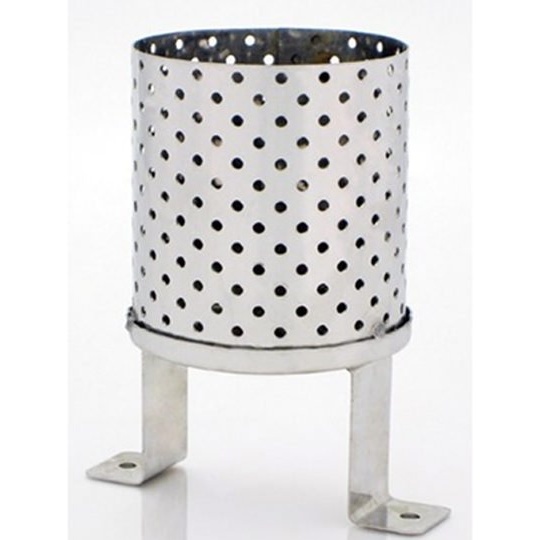
Also, for the lamp, special caps are produced to replace the stationary one, with which the lamp can be used to heat food.
And a little more interesting
Speaking of power. The power of these lighting devices is traditionally measured in such a unit as cp - candlepower (candl - candle, power - power). At that time, our unit was simply called - a candle. So the inscription "luminous intensity of 1000 candles" on the pre-revolutionary leaflets is nothing but the most real technical specifications.
Now this unit is replaced by a more modern - candela. In general, it is not difficult to understand that this unit of measurement of the power of the light flux is equivalent to one candle. The power of this lamp is claimed at 500 cf. There are many comparisons online that 500 cf. is like a 200 watt incandescent lamp. I myself could not find all the necessary information to calculate, perhaps among the readers there are more educated users who will dot all the i. Subjectively, it does not give out 200 watts. A maximum of one hundred. Yes, in comparison with an ordinary kerosene lamp it is heaven and earth, the lamp calmly illuminates the room, but not 200. However, the nets play an important role. I have not yet burned all the Chinese nets that came in the kit (and they were so normal, maybe the former owner took it with a margin). But as advised on the forums - you need to use original grids of branded manufacturers. Perhaps with them the lamp will really give out a greater luminous flux.
And further
For some time now, information about the danger, namely the radioactivity of some nets, has been walking on the Internet. It's true. The best and brightest meshes are really made on the basis of thorium. The radioactive background from them is, in fact, harmless, but the crumbling mesh needs to be urgently blown out in the open, collected with a wet towel. In general, do not allow it to turn into dust and fly around you, with what you will breathe. Otherwise, as I said, thorium nets are the brightest.
That's all, that's such a guide on glow lamps, their Chinese clones, launch. If you do not take into account the forums, then I think this is the most complete article in RuNet on this topic, so I hope it comes in handy! If the topic interests you more deeply, I advise you to click on the links already mentioned, as well as visit the most active forumwhere this is discussed.
That's all, good luck to everyone in your work!

